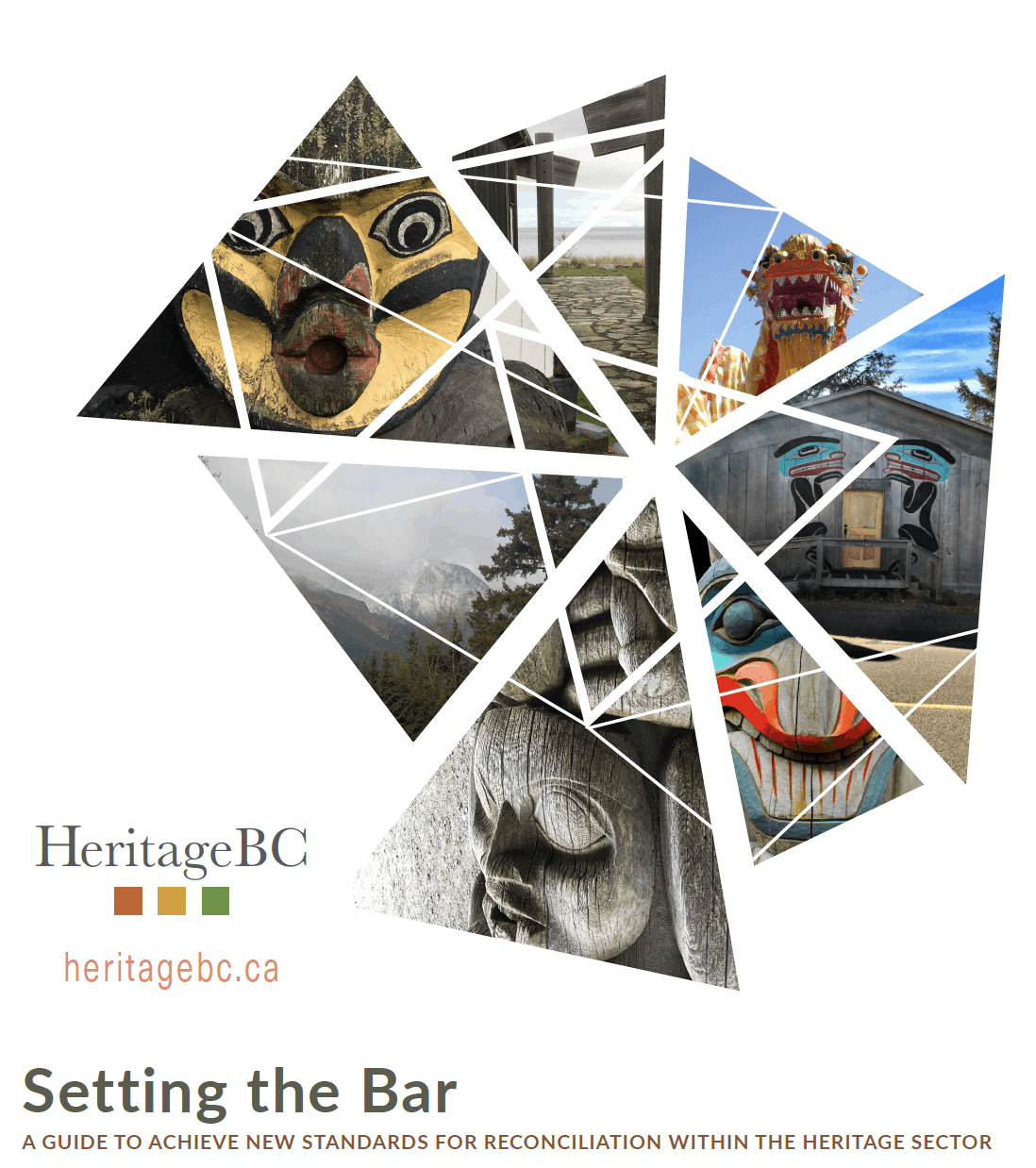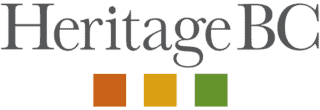- Heritage 101
- Advocacy
- Accessibility for Historic Places
- Climate & Sustainability
- Cultural Maps
- Heritage Place Conservation
- Heritage Policy & Legislation
- Homeowners
- Intangible Cultural Heritage
- Reconciliation
- Indigenous Cultural Heritage
- Setting the Bar: A Reconciliation Guide for Heritage
- 1. Heritage and Reconciliation Pledge
- 2. Acknowledging Land and People
- 3. Celebrating Days of Recognition and Commemoration
- 4. With a Commitment to Learn
- 5. Committing to Strategic Organizational Diversity
- 6. Mission-Making Room for Reconciliation
- 7. Possession, Interpretation, Repatriation and Cultural Care
- 8. Shared Decision Making
- 9. Statements of Significance and other heritage planning documents
- 10. Heritage Conservation Tools, Local Government Act
- Racism: Do Not Let the Forgetting Prevail
- Taking Action: resources for diversity and inclusion
- Webinars On-Demand
1. Setting the Bar: Heritage and Reconciliation Pledge

ACTION: In the spirit of redress and reconciliation and in acknowledging and accepting cultural diversity, adopt the Heritage and Reconciliation Pledge with a board motion.
Download 1. Setting the Bar: Heritage and Reconciliation Pledge
The Heritage and Reconciliation Pledge is a fundamental way for your organization to declare its spirit of reconciliation with and acknowledgement of Indigenous and culturally diverse peoples and communities.
Individually and as an organization, reflect on the contents of this Pledge and consider the intentions of the statements and what they mean to your organization and to the heritage sector. Consider how the statements will positively influence your organization’s relationship with and responsibility to your community and to the lands where you live and work.
All actions are based on the foundation of equitable relationships built on sincerity, truthfulness, openness, transparency, and reliability. The dynamics of relationships are delicate and constantly shifting, requiring us to be constantly monitoring, learning and modifying. Good relationship building never stops.
Seek out the support of staff at the Tribal council or Community Band/Administration office in your area. Note, not all of these will be able to offer public information, as they may focus on providing services to their own members. A strong relationship can result from listening, conversing and showing respect.
If a statement poses challenges to your organization, use the Pledge as a starting point to talk with people in your area. With a willingness to listen, a curiosity to ask, and an openness to learn, this presents a great opportunity to understand other perspectives and experiences and to clarify your organization’s values.
The Pledge’s statements are intentionally broad so that they may serve a range of organizations and situations. To ‘operationalize’ the Pledge, it will be important to consider strategies – the actions – so that your organization is actively and measurably working toward reconciliation. The remainder of the Setting the Bar: A Guide to Achieve New Standards for Reconciliation within the Heritage Sector provides numerous ways for your organization to explore achievable and impactful strategies.
After a thoughtful discussion, the board of directors will approve the Pledge with a motion. You can then share this important step with your membership and community. Put the Pledge on your website, share it at meetings, and include it in operational reports.
Approving the Pledge also provides an opportunity to build relationships with your community by including Indigenous and cultural leaders to witness the signing of the Pledge. The cultural role of a witness should not be underestimated. It signals that you are accountable and want to start things off in the right way.
Keep in mind that the Pledge is not an end goal – it is the beginning of your important work.
Be proud of your first step and be a leader. This is important work towards more equitable future and stories about our society and lands.
Heritage and Reconciliation Pledge
In the spirit of reconciliation and in acknowledging and accepting the cultural diversity of our community and Province, [your organization] pledges to:
- Recognize heritage as the representation of all people and cultures and practice heritage as “the tangible and intangible record of human imprint on the world.” (The State of Heritage)
- Establish and maintain mutually respectful, responsible and welcoming relationships between Indigenous and non-Indigenous peoples – the foundation of reconciliation.
- Acknowledge the harm that has been inflicted on Indigenous and other marginalized communities and commit to action that will change behaviours and repair relations.
- Actively learn more about Indigenous Peoples, cultural diversity, Canada’s history of colonization, and to consider the influences, both positive and negative, our organization has on others as we work toward affirmative change.
- Ensure employment opportunities are open to Indigenous and culturally diverse candidates; ensure career development opportunities are equitably available to all staff members; commit to fair compensation for Indigenous and culturally diverse people.
- Create a working environment that is inclusive, welcoming and safe for Indigenous employees and people of all cultural backgrounds. The workplace environment will promote healing and recovery rather than continue practices and perpetuate conditions that inadvertently re-traumatize.
- Apply the principle “nothing about us, without us” as we involve people whose culture and stories we may wish to include in the development of our programs.
- We will consider ways to best engage and communicate with others, respecting that Indigenous communities each have their own protocols and decision-making processes. Decisions are made through a shared process that involves providing capacity for all parties to participate from preplanning stages to the achievement of outcomes.
- We will be open to evaluating programs and collections to invite new interpretations, relationships, and contexts.
- We will work toward improving access to our programs and to our organization.
- We will move beyond consultation to decision-making roles.
- Commit to generating positive and lasting change as individuals for our organization and leaders for our community.
- Support and engage in public education and advocacy, and practice respect, responsibility, and reciprocity. We believe we should be accountable for our words and actions and we will be humble in our learning and listening.
- Make reconciliation and cultural equity part of our strategic direction, so that we will continue to seek new opportunities for training, education, networking and communication, and self-evaluation. Our goals and timelines will transparent, taking into account the circumstances of those with whom we work and adjusting as needed.
- Ensure Indigenous Peoples and cultural group(s) are involved in the formation of strategies and programs that affect these groups.
- Recognize that the First Peoples of Canada are experts on their own histories and culture, that they have rich knowledge and heritage traditions, and they have rights to express and protect their heritage in their own ways.
We commit to ongoing positive and concrete steps as a catalyst for the increased awareness of the meaning and potential of reconciliation. We recognize we must be part of a collective effort to maintain momentum and we must continually reflect on the places where we reside and work, always respecting the diversity of cultures and experiences that form the richness of our provincial heritage.
The motion to accept the Heritage and Reconciliation Pledge as a guiding document of our vision, values and strategies was made on (date) ______________
Signature of Chairperson ______________
Organization: ______________
Indigenous Witness: ______________
Sources:
Bringing Reconciliation to Healthcare in Canada
Personal Pledge of Reconciliation (Indigenous Corporate Training Inc.)
Professional Pledge of Reconciliation (Indigenous Corporate Training Inc.)
A Reconciliation Framework for Canadian Archives
